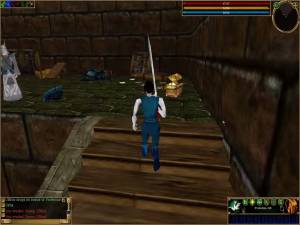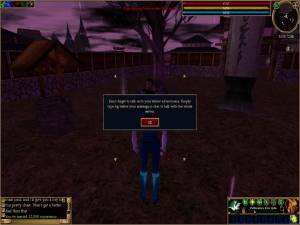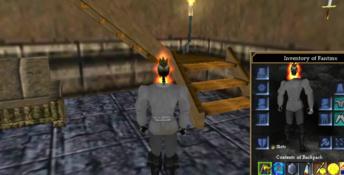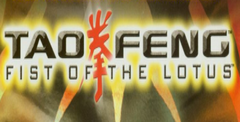Asheron's Call

| a game by | Microsoft |
| Platform: | PC |
| Editor Rating: | 8/10, based on 2 reviews |
| User Rating: | 9.0/10 - 2 votes |
| Rate this game: | |
| See also: | Best MMORPG |
What comes afterEverquest? Asheron's Call, Microsoft's entry into the turbulent world of online RPGs. The action unfolds on a 24-square mile island where players can create customized characters with constantly developing skills and can participate in a unique social structure. The more allies you acquire, the more influence you wield in the game world, which encourages experienced players to squire newbies so that nobody feels left out of the social scene. Add in a strategy combat system and modular magic spells, and Asheron's Call oozes potential.
Download Asheron's Call

System requirements:
- PC compatible
- Operating systems: Windows 10/Windows 8/Windows 7/2000/Vista/WinXP
Game Reviews
Overview
Asheron’s Call is the newest entry in the rapidly thickening genre of Massively Multiplayer Online Role-Playing Games (MMORPGs). On the surface, it seems like a standard sword-and-sorcery kind of thing, but the game goes much deeper than that. The original, and ongoing, back story involves a peaceful world (Dereth) being overrun by evil monsters, led by the insectoid Olthoi. The original race, the Empyrean, was all but wiped out and now only ruins remain of their extensive civilization. The portal magic that brought the Olthoi to Dereth also allowed humanoids to appear and your character is one of those, set to slay the monsters that infest the island and return it to peace once again. Unlike many other games, the storyline here is actually involved in gameplay and the game designers intend to develop the story over the life of the game by having monthly world-wide events that further the plot. Your humanoid character can be either male or female and is one of three races: Aluvian, Sho or Gharun’dim -- the rough equivalent of European, Asian and Middle Eastern. Each race has certain specialties, though none of the races is better than the others. You can customize your character to your heart’s content with specific hair color, facial features, and expressions. You can choose from a preselected assortment of trained skills and attributes or create your own custom character. A quick run through the training hall, then a stop off at the local merchant and you’re on your way.
Gameplay, Controls, Interface
Gameplay takes place in a 3D environment with a wide variety of views from which to play, including a 360 swivel view and a top-down angle which is very useful for wide-range mapping. I’ve found that using the standard behind-the-back view works best for getting a clear look at what’s around you. There is an always-present small chat/action window and a corner control panel, which will bring up your paperdoll, spellbook, options screen, backpack and other items on your right -- including the wonderful global positioning map. Your health, stamina and mana bars are at the top, and in the upper right there’s a great little compass -- one of the best features of the game. There are different colored radar blips on this compass to show you where monsters, fellows and merchants, and other points of interest are -- invaluable for avoiding a nest of nasties when you’re at half-health and trying to get out of a spawn area. All this complication on the control panel is a little confusing at first, but it all makes sense once you get into the game. The keyboard controls are customizable, but the standard setup is to use the arrow keys for movement, the number pad for camera angles, and the main keyboard for all other functions. You also use the mouse, primarily for item selection and moving things around, but there isn’t nearly the same amount of switching from mouse to keyboard that is necessary in other games. There are customizable hotkeys for backpack items (healing kits, weapons, etc) and if you’re playing a mage, you can also set up hot keys for commonly used spells -- which is essential, as trying to fire spells from the on-screen controls takes much longer. The combat interface for warriors is more complex as well, as when you go into war mode -- you get a little bar to select how fast vs. how strong you want your swing to be and whether you want a high, medium, or low attack, depending on what you’re attacking. This too is a little confusing at first, but it adds a great deal of detail and depth to combat that’s lacking in other games. This isn’t about hitting your war toggle and walking away until you hear death cries. While the basic premise of the game is standard monster-slaying RPG, there’s more to life than combat. There are quests, more of which are being added, there is plenty of sight-seeing to do, and there is a lot of social interaction, especially around event times. There are a few trade skills and plans to add more, but for now they’re limited to ones that can actually be useful to someone who specializes in something else. Say, an archer also learning fletching.
Some of the major features of AC include a player-vs.-player switch, (and a PK (Player Killer) only game server) a very detailed magic system which involves four individually trained schools, readily available and polite in-game help via advocates, and a remarkable pyramid scheme of an allegiance system whereby you have vassals swear to you (and you usually give them money, training, or other goodies) and a portion of their experience goes to you. Experience itself is earned through combat and/or through using skills. You gain experience in specific skills as you use them, but you also gain generic experience points, which you can spend on any skill or attribute you wish -- making your character just as customizable on your fifth level as your first. Level numbers aren’t really a strong indication of anything specific, they’re more just a status symbol -- how you’ve spent the many experience points you have is a better indicator of how strong your character is. If you’ve earned 7k points but spent them all on raising your Appraise Item skill, chances are you’ll fare worse in a match with a Blood Shreth than the guy who spent most of his on Melee Defense and Quickness. When you do die (and you will) it’s merely a matter of losing half your cash, one or more (depending on your level) of your most valuable items -- all of which you can retrieve from your corpse without fear of it being looted, unless you’re playing PvP -- and a temporary reduction in skill levels, until you earn back experience to work the penalty off. Annoying, yes (as death should be), but not a total frustrating waste of time.
Multiplayer
Perhaps one of the best features of AC is its ability to support a huge number of players on each "world." They had nearly 3500 players at the end of beta testing and though that did tax the system, that’s still a large number to even fit on one world. There’s definitely machine muscle behind this, but a lot of this is also due to the wise design of the game itself. There’s plenty of monsters, plenty of dungeons and plenty of territory to play in. A few quests have gotten a little crowded, but it’s not nearly as bad as in other games. The map itself is enormous, though it can seem small with the ingenious town-to-town portal subway system. With 25+ major towns (with a lot of wilderness in between) plus the Direlands out to the West, it takes literally hours to run from one end of the map to the other. When/if they ever add housing, I seriously doubt they’ll have the urban sprawl issues that some games had.
Like any online game, they still suffer from some occasional, and unforeseeable issues with lag and cranky servers, but in the month that I’ve been playing the released version, I’ve only seen two instances of non-scheduled downtime and they were brief.
Enemy AI
Monsters are fairly predictable once you get used to them, but they are very complex across the spectrum in terms of behavior, the type of damage they’re likely to do, the range at which they’ll notice and attack you, speed, whether or not they’ll defend others in their pack, etc. Some have high resistance to acid, but are vulnerable to blades; some die faster if you hit ‘em low or high or faster or stronger. There’s quite a bit of detail to it and it's anything but boring. There’s stuff all the way from weenie little Gnawer Shreth to huge Lugians and Tuskers, to some things in the Direlands that can give a person nightmares. They all sound, look, and act nasty as heck. And how powerful a monster is isn’t always dependent on what level it is. A few levels ago, I could take down a level nine Banderling with just a few quick spells, but if you got me in a vicious little pack of level four Mosswarts I’d be dead within a few seconds because they’re faster, they fight together, and frequently throw sharp objects at opponents (my missile defense skill is a little low). It feels a bit like being nibbled to death by guppies, but it’s still death.
Graphics
The 3D environments are gorgeous. In the main, Eastern half of Dereth, it’s merely a lot of countryside and small towns -- with various environmental differences for mountains, deserts, etc. and different architecture for the different races’ towns. They have no need of the flashy color effects used in other games to show off your video card -- it’s simply a very realistic and well-drawn world. The color palette is just a tad cartoonish, but it seems hyperrealistic if anything. If you get the chance, I recommend at some point simply laying down on top of a hill and watching the stars go by and the moons rise. It’s really fab. There are some truly cool visual features here and there as well -- some of the Empyrean ruins are awe-inspiring and there’s nifty artwork on the walls in some buildings. There are fountains that burble, neon swamp gas that rises, geothermal geysers and sparkling waterfalls. I haven’t been to the Direlands yet, but the screenshots I’ve seen from there are even more amazing, and you get a much stronger sense of the depth of the game.
There are highlighted "points of interest" on the map which are fun to go see, and the occasional small but interesting little features, too -- like the Bunny Shrine near Shoushi and the moving windmills in some of the Aluvian towns. They have rain and snow, they have butterflies, birds overhead and falling leaves. Fires flicker and crackle, lanterns and lifestones glow, and items are detailed and realistic. Monsters are scary as all heck to look at, player characters gesture and breathe. Probably the only thing missing here is more realistic water features -- you can wade through lakes and rivers, but you can’t swim, or see under water (kind of a pain when you kill something in the middle of the ocean and then have to hunt for the corpse to loot it) and there are no boats. There is an enormous range of sight, and there’s no visible clip planes at all -- just the occasional flash where a couple of edges come together. The characters are just a tad boxy, even with a good system, but they’re far better than other games at the same development level. On a more personal note, I’m also grateful that they didn’t make their female characters into sword-wielding swimsuit models, either. It’s nice to be able to play a female and not be worried that her platemail armor won’t cover her cleavage. Kudos to whoever fought for that one.
Audio
In some ways, it’s a little odd not to have background music, but considering the number of important action and ambient sounds in the game (3D sound, no less) it would be a terrible distraction. Not to mention that if you play the game for six hours on end (as I’ve been known to do), hearing the same stuff looping over and over gets boring -- I’d rather be listening to Mahler while I’m hacking up Gromnies anyway.
Room for Improvement
Probably the biggest issue in the early days of the release so far has been game balance. In beta, there was some concern that war and life mages were far more powerful than other character classes. They did some tweaking here and there, and a small update shortly after release, to fix this. There is still a perception that mages are more powerful, and they do have advantages (greater range, etc.) but standard weapons users have advantages as well. I’m currently playing a war mage/healer and a pure blademaster. Both are quite specialized in their primary skills, and both have risen at about the same rate, depending on how often I play them. The things that make my war mage seem more powerful is that a) her spells do more damage, from a further range, so she can kill things faster and b) she usually travels with a life/creature mage who gives her plenty of boosts. My blademaster may take longer to kill something, since she has to actually get in and get in the monster’s face to hack on him, but she has higher hit points, and higher strength so she can carry more armor (not to mention more loot -- spell components may be light but mages don’t usually do well carrying around maces they’ve lifted from Banderlings). It’s really a personal call as to what kind of character you want to play, and whether you prefer warm blood and cold steel or the wonderful sound of lightning and acid bolts nailing a beastie from a distance. And, as always, playing in a group with an assortment of skills and specialties is very useful. I can’t count the times I’ve really liked having someone around who can cast Mana Renewal Other on me.
They also had some issues in beta with people "camping" certain spawn points, dungeons, or chests to get specific items. This is still kind of a problem, but they’ve eliminated most of the big areas of concern as far as I can tell and now do slightly more random spawn locations too.
Aside from that, I think probably the biggest error Turbine made when doing their feature design was in not having banks and/or item storage of some sort. From what I understand this is a feature that is planned, but at the moment, it’s a pain to have to create a mule character to store armor, weapons and cool loot on.
Parental Warning
Rated T (Teen) for violence, scary monsters and the sometimes questionable language used by other players. Mature 11- and 12-year-olds can probably handle it, but careful monitoring of their game habits is always wise anyway.
System Requirements
Minimum: Multimedia PC with a Pentium 166 or faster, 32 MB of RAM, IE 3.02 or later, or Netscape 4.0x, Win 9x, Direct X 6.1, 170 MB of free HD space, plus 100 MB for the swap file. 4X+ CD ROM, Super VGA (800 x 600) monitor & video card supporting 16-bit color, 28.8 Kbps modem and of course Internet access. This game is played on Microsoft’s Zone, so you’ll need an account there, too. A good sound card and a 3D card with 8 MB or more of RAM is really essential for the right game experience.
There have been some issues with outdated DirectX drivers causing problems, so make sure you have the latest versions, and definitely go for a decent 3D card. Supported cards are listed at the Microsoft support site
There is also a known issue with the TNT2 Detonator driver. More info on these and other issues can be found on the AC FAQs on Turbine’s site or the Zone.
The graphics and sounds are good enough to make it worthwhile to have a good system. Half the fun in AC is wandering around sight-seeing, so it’s nice to be able to see things as the designers intended.
Documentation
They have a useful playguide!!! I nearly fell over when I saw it, actually. I’ve gotten so used to the rip-off, dry little not-bigger-than-a-CD-insert ones that come in so many games that I almost wet myself reading the vast wealth of information there. A good bestiary of their original monsters, maps to the towns and the vendors therein -- even character naming guidelines (hey, maybe we’ll get fewer K3wld00dz this way). There’s also a quick reference card with chat commands, a keyboard map, a map of the island and skill calculation formulas. More than likely the guide, like any paper guide, will get rather outdated, but for now there’s really no need to go scrounging for other info unless you need intense level details, or you just want cheats and spell formulas, in which case you and your bug-exploiting friends can find that stuff on your own.
Bottom Line
My friends are starting to call it "Asheron’s Crack" due to all the time I’m spending playing it. The editorial staff here actually bickered over who was going to get the first review copy that came in. I’m hearing the death throes of Drudges in my sleep. I love this game. Yes, there are features I would like to see added (most of which are reportedly on the agenda) but I can think of very few things that I want to see fixed, and that’s pretty amazing for a game of this complexity. There is ongoing development and a real dedication from the folks at Turbine to make this a game that can be played for a long time to come. They listen very closely to what players have to say about the game (unconstructive rants about uncontrollable technical issues aside) and also have watched the mistakes and successes of other games to help fix problems before they happen. Turbine is a small, focused company, and I think that has helped them to create a game that people actually like to play. They started putting the game together way back in 1996, and I think the three-year wait has been more than worth it.





































